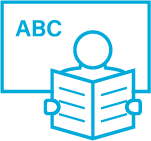Developing Reading Fluency in EFL: How assisted repeated reading and extensive reading affect fluency development

The main objective of the current study is to focus on whether (and how) assisted repeated reading with an auditory reading model enhances English as a foreign language (EFL) readers’ fluency. Quantitative and qualitative analyses of participants’ reading behaviours suggest that assisted repeated reading (RR) is equally as effective as extensive reading (ER) in increasing EFL readers’ silent reading rate, and favourably affects learners’ perceptions of reading activities. The results indicate the specific role played by the repetition and listening components of assisted RR in facilitating reading comprehension.
Authors: Etsuo Taguchi, Miyoko Takayasu-Maass & Greta J. Gorsuch
Source: Taguchi, E., Takayasu-Maass, M., & Gorsuch, G.J. (2004). Developing reading fluency in EFL: How assisted repeated reading and extensive reading affect fluency development. Reading in a Foreign Language, 16(2), 70–96.
Extensive research on reading in a first language has shown the critical role of fluency in successful reading. Cognitive and metacognitive reading strategies and schemata that readers utilise also play important roles in constructing meaning from text. The main objective of the current study is to focus on whether (and how) assisted RR with an auditory reading model enhances EFL readers’ fluency. Quantitative and qualitative analyses of participants’ reading behaviours suggest that assisted RR is equally as effective as ER in increasing EFL readers’ silent reading rate, and favourably affects learners’ perceptions of reading activities. The results indicate the specific role that repetition and listening components of assisted RR play in facilitating reading comprehension.
- There has been sustained interest in promoting reading as a significant and viable means of language development for second and foreign language (L2 and FL) learners.
- ER and RR are two types of reading instruction programmes that have been used in English as a second language (ESL) or EFL settings as effective means of developing reading fluency and comprehension.
- ER is an approach in which readers self-select materials from a collection of graded readers with the goal of reaching specified target times of silent sustained reading.
- In the RR approach, L2 learners read specified passages from graded readers repeatedly to increase learners’ sight recognition of words and phrases, resulting in increases in fluency and comprehension.

The study
The present study investigates whether (and how) RR facilitates fluency development and comprehension. In the current study, one group of L2 learners engaged in an assisted RR programme in which an audiotaped reading model was supplied, while another group of learners engaged in an ER programme.
Research questions:
- Is RR effective in developing fluency in beginning-level FL readers?
- Is RR as effective as ER in developing reading fluency and comprehension of beginning-level FL readers?
- How do beginning-level FL readers perceive the effectiveness of each method?
The participants were drawn from a class of 29 Japanese university students who were learning English as a foreign language. In total, 20 students volunteered to participate in this study. Half of the participants (n = 10) were assigned to the RR group and the other half to the ER group. Participants took pre- and post-tests. The RR group read two books at approximately 4th grade level (United States). Participants in the ER group read three to six books.
Procedure
- This project was conducted over 17 weeks.
- The RR groups had 42 treatment sessions.
- Students read the previous passage to remember what they had read in the last session.
- Students timed their first reading of a passage with a stopwatch.
- Students read the passage twice while listening to the exact audiotaped version with headphones.
- Students read the passage silently two more times and timed each of their readings with a stopwatch.
- Students wrote a book report about what they had read in the story passage.
- The ER group engaged in ER over the same time frame that the RR sessions were held.
- ER participants read books of their choice progressively from easier to more difficult.

Findings
- Results seemed to support the hypothesis that RR is effective in developing fluency in FL readers.
- The RR group read at 83.97 wpm (on average) for the first four sessions and their average reading rate increased to 107.04 wpm for the last four sessions, which was statistically significant.
- Overall, participants read faster within individual RR sessions as they read the text repeatedly. The average gain score from the first to the fifth readings within sessions was 31.42 wpm, which was a statistically significant increase.
- Results suggest that RR and ER are comparable in facilitating participants’ reading fluency, with the RR group having slightly higher wpm reading rates.
- Both RR and ER groups increased their comprehension scores on both pre- and post-tests as the number of readings multiplied.
- The response data from the questionnaire revealed the following themes: 1) changes in participants’ willingness to read long passages; 2) learning to deal with unknown words in a text; and 3) extended exposure to reading input.
- The RR participants’ data was further categorised into two themes: 4) the role of repetition in developing reading fluency and comprehension; and 5) the effect of RR simultaneous audio recordings on participants’ listening skill development.

Conclusions and implications
The present study suggests that RR is effective in increasing the fluency of beginning-level FL readers. The RR participants read somewhat faster than ER participants on the post-test; however, this was not significantly different. However, the RR group was not able to enhance their comprehension performance, even after their word recognition skills improved. Both methods increased readers’ willingness to read long passages and developed their ability to deal with unknown words. The repetition component of RR possibly provides scaffolding for beginning-level reading. RR is as promising a method as ER for enhancing second and foreign language readers’ fluency. As learners become able to read faster, they come to enjoy reading. If they can enjoy reading, their access to language input will increase dramatically, which will further promote their language development.